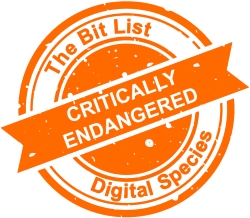Records of Local Government
 |
||
|
Records from local government (i.e., below the state level) which are required for transparency and may be in many diverse forms, but in which the local authority may lack the capacity to manage the complex digital preservation requirements that arise. |
||
|
Digital Species: Public Records |
Trend in 2023:
|
Consensus Decision |
|
Added to List: 2019 |
Trend in 2024:
|
Previously: Critically Endangered |
|
Imminence of Action Action is recommended within twelve months, detailed assessment is a priority. |
Significance of Loss The loss of tools, data or services within this group would impact on people and sectors around the world. |
Effort to Preserve | Inevitability It would require a major effort to prevent or reduce losses in this group, possibly requiring the development of new preservation tools or techniques. |
|
Examples Born digital records of small and medium-sized agencies; fasting-changing internal manuals, advice or policies shared electronically; records of care services; Documentation supporting long-lived contractual relations like Public Finance Initiatives; Organizational Slack channels; network drives; EDRMS; Email. |
||
|
‘Practically Extinct’ in the Presence of Aggravating Conditions Lack of preservation infrastructure; conflation of backup with preservation; loss of authenticity or integrity; Long-lived business processes; poor storage; churn of staff; significant volumes or diversity of data; poorly developed digitization; ill-informed records management; poorly developed migration or normalization; long standing protocols or procedures that apply unsuitable paper processes to digital materials; encryption; political instability; lack of sustained funding; Uncertainty over IPR or the presence of orphaned works. |
||
|
‘Endangered’ in the Presence of Good Practice Well managed data infrastructure; preservation enabled at the point of creation; carefully managed authenticity; use of persistent identifiers; finding aids; well managed records management processes; recognition of preservation requirements; strategic investment in digital preservation; preservation roadmap; participation in digital preservation community. |
||
|
2023 Review This entry was added in 2019 as a subset of a previous entry for ‘Records of long duration from Local Government or Other Government Agencies.’ The split was intended to allow greater concentration on the challenges that these distinct types of agency face. Local government typically operates across a broad range of digital formats and services, but it is unclear and unlikely that relatively small archival agencies are properly funded locally to support the wide range of digital preservation requirements that arise. The 2020 Jury noted a trend towards greater risk based on significant political and economic upheaval placing additional strain on local government and its agencies, making already vulnerable records at greater risk. Trends towards greater risk was also noted by the 2021 Jury and 2022 Taskforce, contributing examples like Grenfell to demonstrate the precarity of local government records, especially when these risks overlap with records of non-governmental agencies, resulting in significance and impact of loss, the impetus for action and call to governing frameworks where failing in enforcement (and depending on the jurisdiction). The 2023 Council generally agreed with the Critically Endangered classification with the overall risks remaining on the same basis as before (‘No change’ to trend). The 2023 Council additionally recommended revisiting and rescoping this entry as part of the next major revision of the Bit List. Some Council members recommended splitting this entry into separate entries to differentiate the various risks associated with different types of digital public records, Others raised concerns regarding the breadth of records held by local government, and that it is perhaps not appropriate to have a distinct entry or split entries for records of local governments but rather provide examples of different kinds of public records in and across other entries. |
||
|
2024 Interim Review These risks remain on the same basis as before, with no significant trend towards even greater or reduced risk (‘No change’ to trend). |
||
|
Additional Comments The diversity of 'local government records' makes this category quite difficult to score. First, local governments have differing responsibilities in different jurisdictions. For example local governments in the UK have more responsibilities than in Australia. Also, given the number of local government agencies in a state or country, the quality of recordkeeping and digital preservation practice can vary greatly. Additionally, the variety of records that are created by local governments means that some formats or record types may be generally at low risk, while others may be practically extinct. Given this complexity it is important to make clear that the imminence of action, significance of loss, and effort to preserve are context-dependent and generalized. The main factors that reduce risk for these records are that local government is regulated, and there are clear recordkeeping standards that apply to digital records. Also they have consistent funding (although it may not be enough and may not be directed at digital preservation). We feel that due to the breadth of records held by local governments, it is perhaps not appropriate for them to have a distinct record series, but rather be a featured example of other series. This approach would still assist in advocacy for local government as they would be able to cross reference their digital holdings against these classifications. Significant research by the UK National Archives into Local Government Archives in England underlines the digital skills shortages that exist, especially with respect to preservation. There may be a benefit from splitting into a) legally required public record and b) additional information that may enrich our digital preservation of society. My assumption was that the roles and requirements for records management are clearly defined, but if this is not the case and there are inadequate resources to match the requirement, then the risk goes up. Case Studies or Examples:
|
||





































































































































